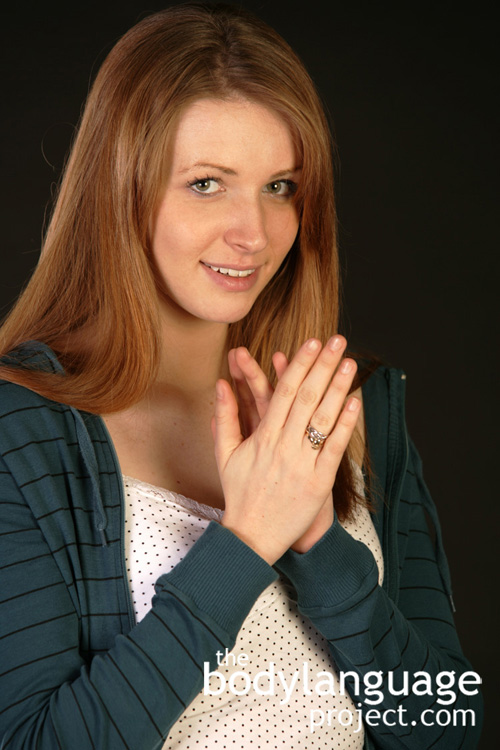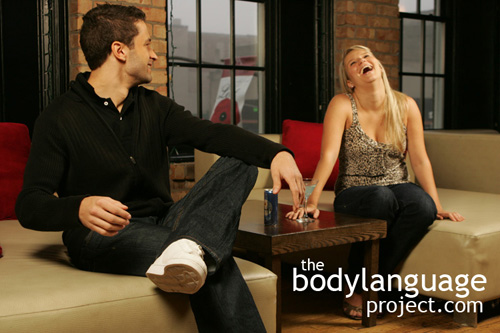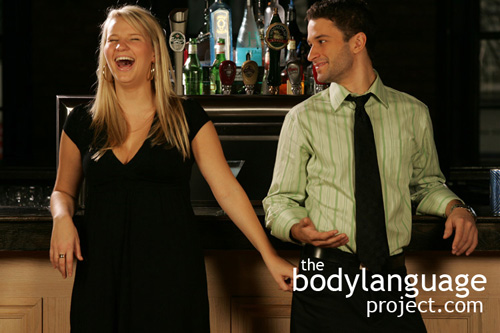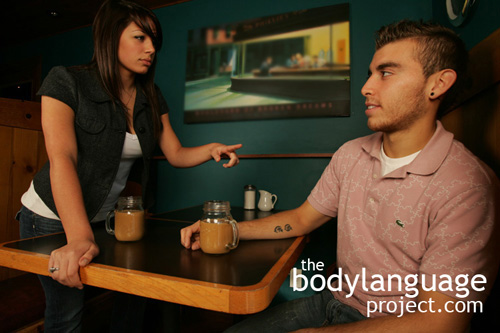Body Language of The Hand Rubbing Gesture
 Cue: Hand Rubbing Gesture.
Cue: Hand Rubbing Gesture.
Synonym(s): Rubbing The Hands.
Description: Rubbing one hand with the other hand, palm-to-palm.
In One Sentence: Rubbing the hands is a sign that someone is preparing to receive something desirable.
How To Use it: Rubbing the hands is a great way to embody hand cleansing which has been shown to produce a mental reset absolving one’s self from moral sin. By figuratively washing the hands, the mind can be more at ease from a transgression. Actually washing the hands also produces the same moral cleansing effect.
Generally, being obvious about your good fortune by rubbing the hands is not advisable because it can raise suspicion or produce jealousy. However, when a shared resource is coming to a group of people, you can share your enthusiasm by rubbing the hands together excitedly.
Context: a) General b) Business.
Verbal Translation: “I’m rubbing my hands to figuratively clean them in preparation to receive something desirable.”
Variant: Hands might cup each other with no rubbing to minimize the likelihood of detection.
Cue In Action: a) It had been a long time before she saw her baby niece. She rubbed her hands together quickly in anticipation of a big bear hug. b) The real estate agent rubbed his hands quickly when the buyer decided to put in an offer over the asking price.
Meaning and/or Motivation: Rubbing the hands signifies the expectation of receiving something.
It has roots in washing the hands to accept goods with hands free of dirt. Hand rubbing occurs just before closing a deal or a sale, when we win a prize, or the expectation to win is present. There are variations in the degree of intensity to which this hand rubbing occurs, and this also provides us with information. For example, rubbing the hands slowly often comes across as devious when accompanied with a smug smile. A used car salesman will slowly rub his hands together as he cooks up a plan to pocket a larger commission for himself at the expense of another.
Slow hand rubbing usually means that good is coming to the sender of the message alone, whereas quick rubbing usually indicates mutual benefit. The slow hand rubber is diminishing and concealing his signal by slowing it down or even possibly hiding it, whereas the fast rubber is making his gesture more obvious with his hands in plain view, so both parties can share in the anticipation. A real estate agent, for example, might have two suitable properties for his client, however, one might yield a higher payout for him, while the other might be more suitable for his client. If hand rubbing slows while he shows one property over the other, he might just be telling everyone which he’d rather sell. It would then be up to the buyer to do his due diligence and be cautious about the agent’s motives. We should always be careful when people rub their hands when it implies that we might benefit others at our expense, and the slower, more concealed the rubbing occurs, the more we should be weary.
Cue Cluster: Widened, alert eyes, eyes may dart around seeking information, hands will remain out of pockets or hidden if the anticipation is trying to be hidden from view, torso will orient toward whomever will be the giver, or if trying to conceal desire, the torso will be aimed away, but only to feign lack of desire. When the object is present, eyes will follow or monitor its location, occasionally darting in its direction.
Body Language Category: Auto contact or self touching, Buy signals, Energy Displacement, Enthusiasm (nonverbal), Excited, High confidence hand displays, Micromessaging.
Resources:
Andric, Michael ; Solodkin, Ana ; Buccino, Giovanni ; Goldin-Meadow, Susan ; Rizzolatti, Giacomo ; Small, Steven L. Brain function overlaps when people observe emblems, speech, and grasping. Neuropsychologia, 2013, Vol.51(8), pp.1619-1629
Alibali, M.W., Heath, D.C., and Myers,H.J. (2001). Effects of visibility between speaker and listener on gesture production: Some gestures are meant to be seen. Journal of Memory and Language, 44, 169–188.
Beattie, G., & Shovelton,H.(1999). Mapping the range of information contained in the iconich and gestures that accompany spontaneous speech. Journal of Language and social Psychology, 18, 438–462.
Biau, E., & Soto-Faraco, S.(2013). Beat gestures modulate auditory integration in speech perception. Brain and Language, 124(2), 143–152.
Bartolo, A.,Cubelli,R.,DellaSala,S.,&Drei,S.(2003).Pantomimes are special gestures which rely on working memory. Brain and Cognition, 53, 483–494.
Bernardis, P.,& Gentilucci,M.(2006).Speech hand gestures are the same communication system. Neuropsychologia, 44, 178–190.
Buccino, G.,Vogt,S., Ritzl, A., Fink, G .R., Zilles, K., Freund, H. J., et al.(2004).Neural circuits underlying imitation learning of hand actions: Anevent-related fMRI study. Neuron, 42, 323–334.
Bond, Michael H., and Hiroshi Komai (1976). “Targets of Gazing and Eye Contact During Interviews: Effects on Japanese Nonverbal Behavior.” In Journal of Personality and Social Psychology (Vol. 34), pp. 1276-84.
Blakeslee, Sandra (1995). “In Brain’s Early Growth, Timetable Maybe Crucial.” In New York Times (“Science Times,” August 29), pp. C1, C3.
Chandler, Jesse ; Schwarz, Norbert. How extending your middle finger affects your perception of others: Learned movements influence concept accessibility. Journal of Experimental Social Psychology. 2009. 45(1): 123-128.
http://bodylanguageproject.com/articles/how-extending-the-middle-finger-affects-perception/
Carmon, Z., & Ariely, D. (2000). Focusing on the forgone: How value can appear so different to buyers and sellers. Journal of Consumer Research, 27, 360–370.
Chen-Bo Zhong and Katie Liljenquist. Washing Away Your Sins: Threatened Morality And Physical Cleansing. Science. 2006; 313, 1451.
http://bodylanguageproject.com/articles/hand-washing-as-indication-of-moral-threat/
Dick, A.S., Goldin-Meadow,S., Hasson,U.,Skipper, J.I., & Small, S.L. (2009). Co- speech gestures influence neural activity in brain regions associated with processing semantic information. Human Brain Mapping, 30, 3509–3526.
DeSteno, D.; Breazeal, C.; Frank, R. H.; Pizarro, D.; Baumann, J.; Dickens, L, and Lee, J. Detecting the Trustworthiness of Novel Partners in Economic Exchange. Psychological Science. 2012. 23, 1549-1556.
http://bodylanguageproject.com/articles/use-body-language-cues-create-trust
Ekman, Paul, and Wallace V. Friesen (1969). “Nonverbal Leakage and Clues to Deception.” In Psychiatry (Vol. 32), pp. 88-106.
Florack, Arnd; Janet Kleber; Romy Busch and David Stöhr. Detaching the ties of ownership: the effects of hand washing on the exchange of endowed products. Journal of Consumer Psychology 24, 2 (2014) 284–289
http://bodylanguageproject.com/articles/washing-the-hands-for-new-beginning-ownership-and-the-endowment-effect/
Fabbri-Destro, M.,& Rizzolatti,G. (2008). Mirror neurons and mirror systems in monkeys and humans. Physiology, 23, 171–179.
Fogassi, L., Gallese,V., Fadiga,L., & Rizzolatti,G. (1998). Neurons responding to the sight of goal directed hand/armactions in the parietal area PF (7b) of the macaque monkey. Society for Neuroscience, 24, 257.5.
Fusaro, M., Harris, P. L., & Pan, B. A. (2012). Head nodding and head shaking gestures in children’s early communication. First Language, 32, 439–458. doi:10.1177/0142723711419326
Grand, Stanley (1977). “On Hand Movements During Speech: Studies of the Role of Self-Stimulation in Communication Under Conditions of Psychopathology, Sensory Deficit, and Bilingualism.” In Norbert Freedman and Stanley Grand, eds., Communicative Structures and Psychic Structures: A Psycholanalytic Interpretation of Communication (New York: Plenum Press), pp. 199-221.
Gentilucci, M., Bernardis, P., Crisi,G., & Dalla Volta, R. (2006). Repetitive transcranial magnetic stimulation of Broca’s area affects verbal responses to gesture observation. Journal of Cognitive Neuroscience, 18, 1059–1074.
Goldin-Meadow, S. (1999).The role of gesture in communication and thinking. Trends in Cognitive Sciences, 3, 419–429.
Goldin-Meadow, S.(2003). Hearing gesture: How our hands help us think. Cam-bridge, MA: Belknap Press of Harvard University Press.
Gräfenhain, M., Behne, T., Carpenter, M., & Tomasello, M. (2009). One-year-olds’ understanding of nonverbal gestures directed to a third person. Cognitive Development, 24, 23–33. doi:10.1016/j.cogdev.2008.10.001
Guidetti, M. (2005). Yes or no? How do young children combine gestures and words to agree and refuse. Journal of Child Language, 32, 911–924. doi:10.1017/S0305000905007038
Gräfenhain, M., Behne, T., Carpenter, M., & Tomasello, M. (2009). One-year-olds’ understanding of nonverbal gestures directed to a third person. Cognitive Development, 24, 23–33. doi:10.1016/j.cogdev.2008.10.001
Goodall, Jane (1986). The Chimpanzees of Gombe: Patterns of Behavior (Cambridge: Belknap Press of Harvard University).
Givens, David B. (1976). An Ethological Approach to the Study of Human Nonverbal Communication (University of Washington Ph.D. dissertation in Anthropology, Ann Arbor: University Microfilms).
Grand, Stanley (1977). “On Hand Movements During Speech: Studies of the Role of Self-Stimulation in Communication Under Conditions of Psychopathology, Sensory Deficit, and Bilingualism.” In Norbert Freedman and Stanley Grand, eds., Communicative Structures and Psychic Structures: A Psycholanalytic Interpretation of Communication (New York: Plenum Press), pp. 199-221.
Hummer, P., Wimmer, H., & Antes, G. (1993). On the origins of denial negation. Journal of Child Language, 20, 607– 618. doi:10.1017/S0305000900008503
Hubbard, A.L., Wilson,S.M., Callan,D.E., & Dapretto, M.(2009). Giving speech a hand: Gesture modulates activity in auditory cortex during speech perception. Human Brain Mapping, 30, 1028–1037.
He, Yifei ; Gebhardt, Helge ; Steines, Miriam ; Sammer, Gebhard ; Kircher, Tilo ; Nagels, Arne ; Straube, Benjamin. The EEG and fMRI signatures of neural integration: An investigation of meaningful gestures and corresponding speech. Neuropsychologia.. 2015. 72: 27-42.
Hansen, Jacqueline. Teaching without talking: teachers need to be aware of more than just the words they speak to children. They also need to monitor the nonverbal messages that they’re sending to students through proximity, eye contact, gestures, and touching. Phi Delta Kappan. 2010. 92(1): 35(6).
Holle, H., & Gunter,T.C. (2007). The role of iconic gestures in speech disambiguation: ERP evidence. Journal of Cognitive Neuroscience, 19, 1175–1192.
Holler, J., Shovelton, H.,& Beattie, G.(2009).Do iconic hand gestures really contribute to the communication of semantic information in a face-to-face context? Journal of Nonverbal Behavior, 33, 73–88.
Hubbard, A.L., Wilson, S. M., Callan, D. E., & Dapretto, M.(2009).Giving speech a hand: Gesture modulates activity in auditory cortex during speech perception. Human Brain Mapping, 30, 1028–1037.
Johnson, E. J., Häubl, G., & Keinan, A. (2007). Aspects of endowment: A query theory of value construction. Journal of Experimental Psychology: Learning, Memory, and Cognition, 33, 461–474.
Katza, Carmit; Irit Hershkowitz; Lindsay C. Malloya; Michael E. Lamba; Armita Atabakia and Sabine Spindlera. Non-Verbal Behavior of Children Who Disclose or do not Disclose Child Abuse in Investigative Interviews. Child Abuse & Neglect. 2012. 36: 12-20.
http://bodylanguageproject.com/articles/reading-nonverbal-behaviour-child-abuse-cases-encourage-children-divulge-information-truth-telling
Kendon,A.(1994).Do gestures communicate? A review. Research on Language and Social Interaction, 27, 175–200.
Knutson, K.M., McClellan,E.M., & Grafman, J.(2008).Observing social gestures: An fMRI study. Experimental Brain Research, 188, 187–198.
Kelly, S. D., Barr, D. J., Church, R. B., & Lynch, K.(1999).Offering a hand topragmatic understanding: The role of speech and gesture in comprehension and memory. Journal of Memory and Language, 40, 577–592.
Kelly, S. D., Creigh, P., & Bartolotti, J.(2009).Integrating speech and iconic gestures in a Stroop-like task: Evidence for automatic processing. Journal of Cognitive Neuroscience, 22, 683–694.
Kelly, S.D., Kravitz, C.,& Hopkins, M.(2004).Neural correlates of bimodal speech and gesture comprehension. Brain and Language, 89(1), 253–260.
Krahmer,E., & Swerts, M.(2007).The effects of visual beats on prosodic prominence: Acoustic analyses, auditory perception and visual perception. Journal of Memory and Language, 57, 396–414.
Krauss, R. M., Dushay, R.A., Chen,Y., & Rauscher, F.(1995).The communicative value of conversational hand gesture. Journal of Experimental Social Psychology, 31(6), 533–552.
Kenner, Andrew N. (1993). “A Cross-Cultural Study of Body-Focused Hand Movement.” In Journal of Nonverbal Behavior (Vol. 17, No. 4, Winter), pp. 263-79.
Leonard, T., & Cummins, F.(2010).The temporal relation between beat gestures and speech. Language and Cognitive Processes, 26, 1457–1471.
Lindenberg, R., Uhlig,M., Scherfeld,D., Schlaug,G., & Seitz, R.J.(2012).Commu- nication with emblematic gestures: Shared and distinct neural correlates of expression and reception. Human Brain Mapping, 33, 812–823.
Montgomery, K.J., Isenberg, N., & Haxby,J.V. (2007). Communicative hand gestures and object-directed hand movements activated the mirror neuron system. Social Cognitive and Affective Neuroscience, 2, 114–122.
Molnar-Szakacs, Istvan ; Wu, Allan D ; Robles, Francisco J ; Iacoboni, Marco Robertson, Edwin (Academic Editor). Do You See What I Mean? Corticospinal Excitability During Observation of Culture-Specific Gestures (Gesture Perception). PLoS ONE. 2007. 2(7): p.e626.
Morris, Desmond (1994). Bodytalk: The Meaning of Human Gestures (New York: Crown Publishers).
McGrew, W. C. (1972). “Aspects of Social Development in Nursery School Children with Emphasis on Introduction to the Group.” In N. G. Blurton Jones, ed., Ethological Studies of Child Behaviour (Cambridge: University Press), pp. 129-56.
Ohgami, Y., Matsuo,K., Uchida,N., & Nakai,T. (2004). An fMRI study of tool-use gestures: Body partas object and pantomime. Neuroreport, 15, 1903–1906.
Pease, Barbara and Allan Pease. 2006. The Definitive Book of Body Language Hardcover. Bantam.
Pugh, George E. (1977). The Biological Origin of Human Values (New York: Basic Books).
Rosenfeld, Howard (1973). “Nonverbal Reciprocation of Approval: An Experimental Analysis.” In Argyle *, pp. 163-72.
Sommer, Robert (1969). Personal Space: The Behavioral Basis of Design (Englewood Cliffs, New Jersey: Prentice-Hall).
Schnall, S., Benton, J., & Harvey, S. (2008). With a clean conscience: Cleanliness reduces the severity of moral judgments. Psychological Science, 19, 1219–1222.
Skipper, J.I., Goldin-Meadow, S., Nusbaum,H.C.,& Small,S.L. (2007).Speech- associated gestures, Broca’s area, and the human mirror system. Brain and Language, 101, 260–277.
Sherzer, Joel The Brazilian Thumbs-Up Gesture. Journal of Linguistic Anthropology, 1991, Vol.1(2), pp.189-197
Straube,B., Green,A., Bromberger,B., & Kircher, T. (2011).The differentiation of iconic and metaphoric gestures: Common and unique integration processes. Human Brain Mapping, 32, 520–533.
Straube, Benjamin ; Green, Antonia ; Jansen, Andreas ; Chatterjee, Anjan ; Kircher, Tilo. Social cues, mentalizing and the neural processing of speech accompanied by gestures. Neuropsychologia. 2010. 48(2): 382-393.
Tam, C. W., & Stokes, S. F. (2001). Form and function of negation in early developmental Cantonese. Journal of Child Language, 28, 373–391. doi:10.1017/S0305000901004688
Villarreal, M., Fridman,E.A., Amengual,A., Falasco,G., Gerscovich,E.R., Ulloa,E.R., et al. (2008). The neural substrate of gesture recognition. Neuropsychologia, 46, 2371–2382.
Vaidyanathan, R. (1991). Development of forms and functions of negation in the early. tages of language acquisition: A study in Tamil. Journal of Child Language, 18, 51–66. doi:10.1017/S0305000900013295
Willems, R.M., Ozyurek,A., & Hagoort,P.(2007).When language meets action:The neural integration of gesture and speech. CerebralCortex, 17, 2322–2333.
Wieser, Matthias J.; Tobias Flaisch and Paul Pauli. Raised Middle-Finger: Electrocortical Correlates of Social Conditioning with Nonverbal Affective Gestures. 2014. PLoS ONE 9(7): e102937. doi:10.1371/journal.pone.0102937
http://bodylanguageproject.com/articles/powerful-nonverbal-effect-raised-middle-finger-persistent-brain-consequences-pairing/
Wu, Y. C., & Coulson, S.(2005).Meaningful gestures: Electrophysiological indices of iconic gesture comprehension. Psychophysiology, 42, 654–667.
Wang, Lin ; Chu, Mingyuan Neuropsychologia. The role of beat gesture and pitch accent in semantic processing: An ERP study. 2013, Vol.51(13), pp.2847-2855
Xu,J., Gannon,P.J., Emmorey,K., Smith,J.F., & Braun,A.(2009). Symbolic gestures and spoken language are processed by a common neural system. Proceedings of the NationalAcademyofSciences, 106, 20664–20669.
Xu, A. J., Zwick, R., & Schwarz, N. (2012). Washing away your (good or bad) luck: Physical cleansing affects risk-taking behavior. Journal of Experimental Psychology: General, 141, 26–30.
Zhong, C. B., & Liljenquist, K. (2006). Washing away your sins: Threatened morality and physical cleansing. Science, 313, 1451–1452.
Zhong, C. B., Strejcek, B., & Sivanathan, N. (2010). A clean self can render harsh moral judgment. Journal of Experimental Social Psychology, 46, 859–862.







